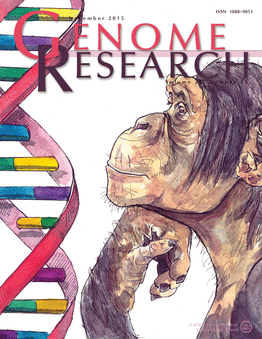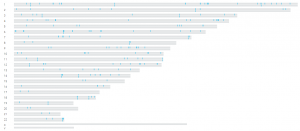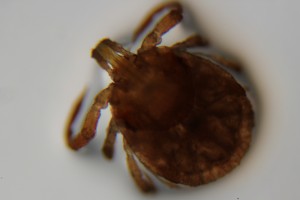https://www.nytimes.com/2018/02/05/science/mutant-crayfish-clones-europe.html
Since the sequencing of the neandertal genome and subsequent additional archaic genomes, evidence of neandertal introgession (hybridization and backcrossing) has been found in nearly all non-african human genomes studied to date. For instance, I am ~2% neandertal and the distribution of neandertal alleles across current human genomes is scattered across all 22 autosomes. For instance, here are the neandertal markers detected across my genome (from 23andMe):
Late neandertal genomes (<50,000 years old) also have evidence of human introgression. When I teach about neanderthal ancestry in Evolutionary Biology, students often ask: “If neandertals and humans successfully mated, then aren’t we the same species?”. That, of course, all depends on your definition of “species”. Leaving that complex discussion aside, another fascinating observation from the analysis of archaic genomes has been that the neandertal contribution to the human genome has been found along all nuclear chromosomes except the Y (see my chromosomes above). This observation has been explained by a number a possibilities:
1. The Y chromosome is relatively small and any neandertal contributions to the human Y could have been lost by chance (genetic drift) over the last 40,000 or so years.
2. Natural selection could have maintained advantageous neandertal alleles and purified out deleterious ones, implying that Y-linked neandertal genes were BAD for H. sapiens.
3. Hybridization between human and neandertals may have only involved human males mating with neandertal females (“war brides”?).
4. Neandertal Y chromosomes may have been incompatible with human biology, or at least reduced the fertility of hybrid males with neanderthal fathers, due to significant divergence of the two species for over half a million years (neanderthal ancestors left Africa long before humans).
A new paper out takes a look at the neandertal Y chromsome and has some new evidence that supports number 4, and may also help us answer that species question as well, although none of the explanations above are completely mutually exclusive or inconsistent with available evidence. Interestingly, the authors find “missense mutations in genes that produce male-specific minor histocompatibility (H-Y) antigens”, some of which are thought to “to elicit a maternal immune response during gestation”. In other words, male embyros with neandertal Y chromosomes may have ended in natural abortions at an early embryonic stage, making it impossible for Y-linked neandertal genes to accumulate in human populations. Under this scenario, female offspring of human-neandertal hybrids were viable, as were male hybrids with human fathers.


Abstract: Knowledge of the genome-wide rate and spectrum of mutations is necessary to understand the origin of disease and the genetic variation driving all evolutionary processes. Here, we provide a genome-wide analysis of the rate and spectrum of mutations obtained in two Daphnia pulex genotypes via separate mutation-accumulation (MA) experiments. Unlike most MA studies that utilize haploid, homozygous, or self-fertilizing lines, D. pulex can be propagated ameiotically while maintaining a naturally-heterozygous, diploid genome, allowing the capture of the full spectrum of genomic changes that arise in a heterozygous state. While base-substitution mutation rates are similar to those in other multicellular eukaryotes (~4 x 10-9 per site per generation), we find that the rates of large-scale (>100 kb) de novo copy-number variants (CNVs) are significantly elevated relative to those seen in previous MA studies. The heterozygosity maintained in this experiment allowed for estimates of gene-conversion processes. While most of the conversion tract lengths we report are similar to those generated by meiotic processes, we also find larger tract lengths that are indicative of mitotic processes. Comparison of MA lines to natural isolates reveals that a majority of large-scale CNVs in natural populations are removed by purifying selection. The mutations observed here share similarities with disease-causing complex, large-scale CNVs, thereby demonstrating that MA studies in D. pulex serve as a system for studying the processes leading to such alterations.
http://genome.cshlp.org/content/early/2015/10/30/gr.191338.115.abstract
from Dan Graur’s upcoming book on Molecular and Genome Evolution:
from the internet. original source unknown. very neat.
You are at least 8% virus! The human genome contains roughly 20,000 protein-coding genes whose coding sequences comprise only about 1.5% of your 3.2 billion base-pair genome. It turns out that over the course of evolution, the lineage leading to humans experienced numerous retroviral insertions into germ line chromosomes. Most of these remnant viral sequences are non-functional today, but we carry them as molecular fossils. However, some genes introduced into our genome by viruses were co-opted for new functions, including a gene that makes the protein syncytin, an essential player in placental development. Did viruses make mammalian evolution possible? It looks like it. In my Viral Genetics class this semester, we will be investigating the diverse ways in which viruses manipulate the genetic processes of their host cell, the role that viruses play in disease and the ways in which viruses have shaped the biology of other organisms over evolutionary time. We generally think of viruses as pests and parasites, but would we exist without them?
More info:
http://www.pnas.org/content/110/9/E828.full
http://journals.plos.org/plosgenetics/article?id=10.1371/journal.pgen.1003400
http://rstb.royalsocietypublishing.org/content/royptb/368/1626/20120507.full.pdf
Interesting paper on the human sex ratio that suggests that there may not be a biased sex ratio at conception. Males suffer spontaneous abortion early and late in development, however female fetuses have overall higher mortality during middle stages of pregnancy, leading to an overall male-biased sex ratio at birth. Check it out:
SAU offers Bachelor of Science degrees in Biology with special program options in Marine Biology, Wildlife Biology and Pre-Health. Our B.S. in Biological Sciences is the most general option that allows for a broad preparation in the diverse fields of Biology, while the B.S. Biology Pre-Health program is designed for students preparing for medical-related fields.
While going for a nature walk in Logoly State Park last week, I must have stepped in a tick nest. A few hours after our hike, I found dozens of nymph-stage ticks (I think deer or dog ticks) all over my ankles, feet, legs, thighs and derriere. They were such small dark specs that I could not make out what kind of bug they were, but I saved a few of them and took a look under the scope. They are definitely tiny ticks, what I later found are referred to a “seed ticks”, the nymph stage of either deer or dog ticks:
The day after my encounter, I was increasingly itchy all over and found hundreds of bites across my body (I’ll spare you the pictures). Today, three days later, I am still applying lots of anti-itch creams and trying not to scratch. Vinegar helps with immediate relief, but the creams are longer-lasting. Anyhow, watch out for these!



